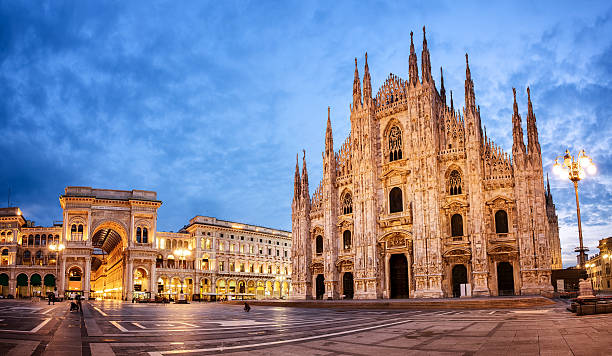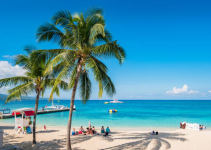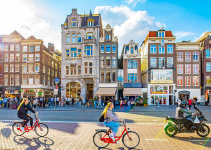Milan gets you in ways other Italian cities don’t. There’s no postcard-perfect canal system like Venice, no ancient ruins sprawling across hilltops like Rome. What Milan has is style, substance, and a pace that feels refreshingly modern for Italy.
But here’s the thing. This city can also trip you up if you show up unprepared. From overpriced tourist traps to unwritten social rules, Milan has its own quirks that separate the smooth travelers from the frustrated ones.
Your experience here hinges on knowing what to skip, what to question, and where not to waste your time or euros. Let’s get into it.

Things to Avoid in Milan
Milan rewards the informed traveler and punishes the unprepared one. Here’s what you need to sidestep to make your trip memorable for all the right reasons.
1. The Restaurants Directly Facing Piazza del Duomo
Walking into Piazza del Duomo for the first time hits different. That Gothic cathedral towers over you, all white marble and spires reaching up like frozen lightning. Your stomach’s growling, and look, there’s a restaurant right there with outdoor seating and a view.
Stop. Walk away.
Those restaurants ringing the piazza charge outrageous prices for mediocre food. We’re talking €8 for a small bottle of water, €25 for a basic pasta that tastes like it came from a package. The servers know you’ll never return, so there’s zero incentive to give you quality. You’re paying for the real estate, not the meal.
Head literally two or three streets away from the square. The Milanese eat at places like Luini for panzerotti (€5 and absolutely worth standing in line), or any trattoria where you hear locals speaking Italian at lunch. That’s your signal. If the menu has pictures and five languages, keep walking. The best meal I had in Milan cost €12 total and was tucked behind a residential building where the waiter barely spoke English. That’s what you’re looking for.
2. Buying “Designer” Bags from Street Vendors
Street vendors will approach you near every major tourist site. They’ve got spreads of handbags that look suspiciously like Gucci, Prada, Louis Vuitton. The prices seem almost reasonable.
Here’s what most travel guides won’t tell you clearly enough. Buying counterfeit goods in Italy isn’t just frowned upon. It’s actually illegal for the buyer too, not just the seller. Italian police can fine you up to €10,000 for purchasing fake designer items. Do they always enforce it? No. But do you want to risk your vacation budget on that gamble?
Beyond the legal risk, you’re getting garbage quality. These bags fall apart within weeks. The stitching unravels, the handles snap, the zippers jam. You’d get better value from a €30 bag at a legitimate store that doesn’t pretend to be something it’s not.
Plus, and this matters, Milan is the actual fashion capital where these brands were born. Wearing an obvious fake here is like showing up to a wine tasting in Bordeaux with a box of Franzia. People notice, and not in a good way.
3. Skipping Advance Tickets for Major Attractions
Milan’s biggest draws require planning. The Last Supper viewing at Santa Maria delle Grazie? Those tickets sell out weeks, sometimes months ahead. You can’t just show up. The painting is in a climate-controlled room that only allows 25 people at a time for 15-minute slots. Without a reservation, you’re not getting in.
Same goes for the Duomo rooftop. Yes, you can often buy tickets the same day, but you’ll wait in a line that snakes around the building for an hour or more during peak season. Book online the night before and you’ll walk past everyone straight to security.
La Scala Theatre Museum sometimes has same-day availability, but if there’s a rehearsal or performance, they close sections without warning. The Sforza Castle museums get crowded by midday. Pinacoteca di Brera fills up on weekends.
Your time in Milan is limited. Spending two hours in ticket lines instead of actually seeing things is a waste you’ll regret. Most attractions let you book online weeks in advance. Take 20 minutes before your trip to secure your spots. Future you will be grateful.
4. Relying on Taxis When the Metro Does the Job
Milan’s metro system is clean, efficient, and dirt cheap compared to taxis. A single metro ride costs €2.20 and takes you almost anywhere you need to go. A taxi from Centrale station to the Duomo? That’s €15-20 for a trip the metro does in 10 minutes for those same €2.20.
The M1 (red line), M2 (green line), and M3 (yellow line) cover all the major tourist spots and neighborhoods. The trains run frequently from about 6 AM until midnight. The stations have clear signage in English. It’s honestly harder to mess up the metro than to use it correctly.
Taxis make sense in specific situations. Late night when the metro’s closed. If you’ve got heavy luggage and you’re heading somewhere the metro doesn’t reach. When you’re traveling as a group of four and splitting the fare makes it reasonable. But for solo travelers or couples moving around during the day? You’re just burning money for no benefit.
One warning though. Always use official white taxis or ride-sharing apps. Random people offering “taxi” services at the train station will overcharge you wildly and might not even have proper licensing or insurance. If it doesn’t have a taxi sign on top and a meter inside, it’s not legit.
5. Treating Milan Like a Quick Day Trip
Some travelers try to “do” Milan in four hours between trains. They sprint to the Duomo, snap photos, grab a pizza slice, and bounce. What a mistake.
This city operates on layers. Surface Milan gives you the cathedral and shopping galleries. That’s fine, but it’s like judging a person based on their Instagram. Spend an extra day, even just one more evening, and you start seeing how the city actually breathes.
The aperitivo tradition, for instance. This isn’t just happy hour. Between roughly 6 PM and 9 PM, bars in neighborhoods like Navigli and Brera serve drinks with elaborate buffets of food. You buy a cocktail for €8-10, and you can eat enough small plates to call it dinner. But more than that, it’s when locals unwind, socialize, and catch up. The energy shifts. The city stops rushing and starts enjoying itself.
You miss all of this with a day-trip approach. You miss stumbling into a hidden courtyard with Renaissance arcades. You miss the smaller museums that tell better stories than the famous ones. You miss watching the sunset paint the Duomo pink while sipping wine at a café where nobody’s in a hurry.
Milan rewards the patient traveler. Give it at least two full days, three if you can swing it. The city will surprise you.
6. Ignoring Italian Dining Schedule and Etiquette
Americans especially struggle with this one. Italian restaurants operate on a schedule that feels backwards to many visitors. Most places don’t start serving dinner until 7:30 PM, with peak dining hitting around 9 PM or later. Show up at 5:30 PM expecting dinner, and you’ll find locked doors or confused looks.
Lunch follows similar rules. Real lunch service runs from about 12:30 PM to 2:30 PM. Some traditional spots close entirely between lunch and dinner, reopening only around 7 PM. This catches people off guard when they want a late lunch at 3 PM and everything’s shuttered except tourist traps and chain restaurants.
Coffee culture has its own code too. Italians drink cappuccinos only in the morning, typically before 11 AM. Order one after lunch or dinner, and you’re marking yourself as a tourist. Not that anyone will stop you, but locals find it odd. The afternoon and evening drinks are espresso or macchiato.
Standing at the bar versus sitting at a table changes the price. That espresso costs €1.20 at the bar but €3.50 if you sit down. You’re paying for table service and the privilege of occupying that seat. Neither choice is wrong, but know what you’re getting into price-wise.
Service charges sometimes appear on the bill as “coperto.” This covers bread and the table setup, usually €2-3 per person. It’s standard, not a scam. Tipping isn’t expected the way it is in America. Italians might round up the bill or leave a few euros for excellent service, but 20% tips aren’t part of the culture.
7. Dressing Like You’re at the Beach
Milan takes appearance seriously. This isn’t snobbery, it’s just how the city operates. Fashion matters here professionally, socially, and culturally. People put thought into how they present themselves.
Walking around in flip-flops, athletic shorts, and a tank top immediately flags you as an oblivious tourist. You’ll feel out of place in restaurants, shops, and museums. Some churches, including the Duomo, enforce actual dress codes. They’ll deny entry if your shoulders aren’t covered or if you’re wearing shorts above the knee.
This doesn’t mean you need designer clothes or uncomfortable outfits. Smart casual works perfectly. Clean jeans or casual pants, a decent shirt or blouse, and comfortable walking shoes that aren’t gym sneakers. Women can wear sundresses if they bring a light scarf or cardigan for church. Men should pack at least one collared shirt.
The Milanese have a phrase: “fare bella figura,” which roughly translates to “making a good impression.” It’s about showing respect for yourself and others through presentation. When you dress appropriately, you fit in better, you’re treated better, and honestly, you feel more confident exploring the city.
Pack light layers since the weather can shift. Bring comfortable but presentable shoes because you’ll walk miles on cobblestones and marble. A simple scarf solves multiple problems, keeping you warm and covering your shoulders for church entry. It’s not complicated, just requires a bit more thought than some other destinations.
8. Visiting During August
Milan practically empties in August. This is when Italians take their summer holidays, and that includes the people who run shops, restaurants, galleries, and even some hotels. You’ll find “Chiuso per Ferie” (Closed for Vacation) signs everywhere.
The city gets oppressively hot. We’re talking 35°C (95°F) days with humidity that makes the air feel thick. There’s no ocean breeze like in coastal Italian cities. The heat just sits there, trapped between buildings, making sightseeing genuinely unpleasant.
Many of the best local restaurants shut down for two to three weeks. The owner and chef take their own vacation, closing the whole operation. You’re left with tourist-focused places and chains that stay open specifically because locals are gone. The food quality drops noticeably.
Cultural events slow down or stop. Fashion Week doesn’t happen in August. Furniture Week is in April. The opera house has limited programming. Even some museums reduce their hours or close for maintenance.
If you have flexibility, visit Milan in spring (April-May) or fall (September-October). The weather’s comfortable, the city’s fully operational, and you get the authentic Milan experience. June and early July work too if you don’t mind the warmth. Just skip August unless you’re on a tight budget and don’t mind compromises.
9. Only Hitting the Famous Spots Everyone Knows
The Duomo is magnificent, truly. The Galleria Vittorio Emanuele II shopping arcade is stunning. Everyone should see The Last Supper. These highlights earn their reputation.
But Milan’s personality lives in places most visitors skip. The Brera district has art galleries tucked into old buildings, craft workshops, and wine bars where you’ll sit next to architects and artists. Navigli, with its canals and vintage markets on the last Sunday of each month, feels completely different from central Milan’s corporate polish.
The Cimitero Monumentale isn’t a typical tourist sight because, well, it’s a cemetery. But it’s also an outdoor museum of elaborate sculpture and architecture where wealthy Milanese families built ornate tombs. Walking through is surprisingly moving and beautiful.
Fondazione Prada, the contemporary art space designed by Rem Koolhaas, shows you Milan’s modern creative side. It’s in a former distillery, and the exhibitions change regularly. The bar there, designed by Wes Anderson, is worth a coffee even if you skip the museum.
Sunday morning flea markets at Navigli Grande or near the Darsena area give you a taste of local life. People are shopping for vintage clothes, antique furniture, and random collectibles. No tourist marketing, just Milan doing its thing.
Corso Como 10 combines a concept store, gallery, restaurant, and hotel in one space. It’s very Milan, very stylish, but also approachable. You can browse without buying, grab a drink at the garden café, soak up the atmosphere.
These spots won’t show up on every itinerary, but they’ll give you stories and experiences that feel more personal than crowd-surfing through the cathedral.
10. Expecting Everyone to Speak English Fluently
Milan is more international than many Italian cities, true. Plenty of people speak English, especially in hotels, major restaurants, and tourist sites. But assuming everyone does sets you up for frustration.
Small family-run trattorias, neighborhood shops, local markets? English isn’t guaranteed. The older generation, especially, might not speak it at all. Even younger locals might know enough for basic transactions but struggle with complex requests or conversations.
Learning maybe 15-20 Italian phrases makes a massive difference. “Buongiorno” (good morning), “per favore” (please), “grazie” (thank you), “mi scusi” (excuse me), “non parlo italiano” (I don’t speak Italian), “parla inglese?” (Do you speak English?). These basic courtesies open doors.
Italians appreciate effort. Attempting their language, even badly, shows respect. People become more patient, more helpful when you try. Just jumping straight into English can come across as entitled, like you expect them to accommodate you without any effort from your side.
Download Google Translate on your phone and grab the Italian offline package before you go. The camera translation feature lets you point your phone at menus or signs for instant translation. The voice feature handles basic conversations. It’s not perfect, but it bridges gaps effectively.
Menu Italian is its own beast. Download a food glossary or cheat sheet. Knowing the difference between “vitello” (veal), “manzo” (beef), and “maiale” (pork) prevents ordering surprises. Understanding what “al forno” (baked) versus “fritto” (fried) means helps you make better choices.
The Milanese aren’t unfriendly, despite what some visitors claim. They’re just busy, direct, and they expect you to meet them halfway with basic courtesy. Make the effort and you’ll find them warm, helpful, and genuinely interested in making sure you enjoy their city.
Wrapping Up
Milan shows you a side of Italy that doesn’t rely on ancient history or romantic clichés. It’s a working city, a creative city, a place where Italians actually live modern lives while still respecting tradition.
Your experience depends heavily on preparation and awareness. Avoid these common mistakes and you’ll spend less money, waste less time, and connect more authentically with what makes Milan special. You’ll eat better, see more, and probably want to come back.
This city has a way of growing on people who give it a real chance. Show up informed, stay curious, and let Milan surprise you.


